Introducing the MySQL large table optimization solution
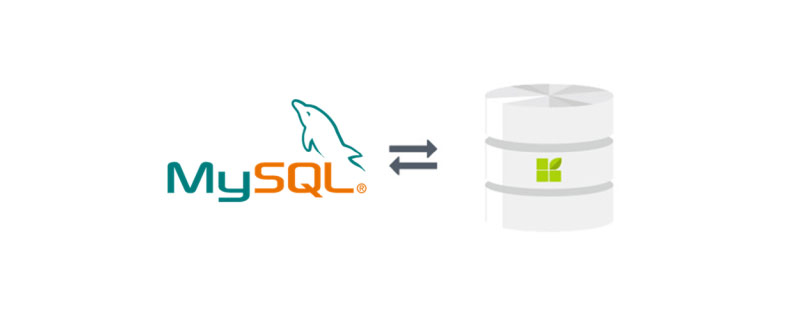
Free learning recommendation: mysql database(Video )
Background
Alibaba Cloud RDS FOR MySQL (MySQL version 5.7) database business table adds more than 10 million new data every month. As the amount of data continues to increase, slow queries on large tables appear in our business. During peak business periods, slow queries on the main business table take dozens of seconds, seriously affecting the business
Program Overview

1. Database design and index optimization
The MySQL database itself is highly flexible, resulting in insufficient performance and heavy reliance on the developer's table design capabilities and indexing Optimization capabilities, here are some optimization suggestions
- Convert the time type to timestamp format, store it in int type, build an index to increase query efficiency
- It is recommended that the field definition is not null, null Values are difficult to query and optimize and occupy additional index space
- Use TINYINT type instead of enumeration ENUM
- To store precise floating point numbers, DECIMAL must be used instead of FLOAT and DOUBLE
- The field length is serious According to business needs, do not set it too large
- Try not to use the TEXT type. If you must use it, it is recommended to split the infrequently used large fields into other tables
- MySQL has restrictions on the length of index fields. Yes, the length of each index column of the innodb engine is limited to 767 bytes by default, and the sum of the lengths of all index columns cannot be greater than 3072 bytes (mysql8.0 single index can create 1024 characters)
- 大If the table has DDL requirements, please contact the DBA
Leftmost index matching rule
As the name suggests, it means leftmost priority. When creating a combined index, it should be used in the where clause according to business needs. The most frequent column is placed on the far left. A very important issue in a compound index is how to arrange the order of columns. For example, if the two fields c1 and c2 are used after where, then the order of the index is (c1, c2) or (c2, c1). The correct approach is to repeat The smaller the value, the higher it is placed. For example, if 95% of the values in a column are not repeated, then this column can generally be placed at the front.
- Compound index index(a,b,c)
- where a=3 only uses a
- where a=3 and b=5 uses a,b
- where a=3 and b=5 and c=4 uses a, b,c
- where b=3 or where c=4 No index is used
- where a=3 and c=4 Only a
- where a=3 and b> 10 and c=7 uses a,b
- where a=3 and b like 'xx%' and c=7 uses a,b
- which is actually equivalent to creating multiple indexes: key (a), key(a,b), key(a,b,c)
2. Switch the database to PloarDB read-write separation
PolarDB It is a next-generation relational cloud database self-developed by Alibaba Cloud. It is 100% compatible with MySQL. The storage capacity can reach up to 100 TB. A single database can be expanded to up to 16 nodes. It is suitable for diversified database application scenarios of enterprises. PolarDB adopts an architecture that separates storage and computing. All computing nodes share a copy of data and provides minute-level configuration upgrades and downgrades, second-level fault recovery, global data consistency, and free data backup and disaster recovery services.
- Cluster architecture, separation of computing and storage
PolarDB adopts a multi-node cluster architecture. There is a Writer node (master node) and multiple Reader nodes (read-only nodes) in the cluster. Each node Sharing the underlying storage (PolarStore) through the distributed file system (PolarFileSystem) - Read-write separation
When the application uses the cluster address, PolarDB provides external services through the internal proxy layer (Proxy), and the application All requests go through the proxy first and then access the database node. The proxy layer can not only perform security authentication and protection, but also parse SQL, send write operations (such as transactions, UPDATE, INSERT, DELETE, DDL, etc.) to the master node, and evenly distribute read operations (such as SELECT) to multiple nodes. Read nodes realize automatic read and write separation. For applications, it's as simple as using a single point of database.
In offline mixed scenarios: different services use different connection addresses and use different data nodes to avoid mutual influence
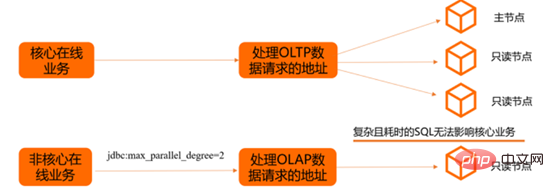
Sysbench performance stress test Report:
- PloarDB 4-core 16G 2 units
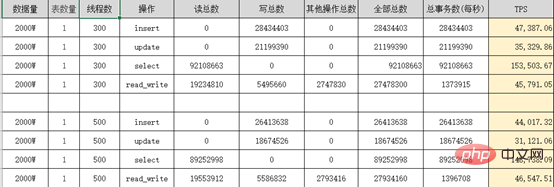

- ##PloarDB 8-core 32G 2 units
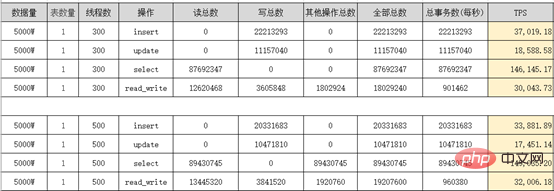

The split business table retains 3 months of data (this is based on the company's needs). Historical data is split into historical database X-Engine storage engine tables on a monthly basis. Why should we choose X-Engine storage engine tables? What are its advantages? ? X-Engine is an online transaction processing (OLTP) self-developed by Alibaba Cloud Database Product Division. Processing) database storage engine. 4. Parallel query of Alibaba Cloud PloarDB MySQL8.0 version After splitting the tables, our data volume is still very large Large, it does not completely solve our slow query problem, but only reduces the size of our business tables. For these slow queries, we need to use PolarDB’s parallel query optimization PolarDB MySQL 8.0 launches the parallel query framework , when the amount of your query data reaches a certain threshold, the parallel query framework will be automatically started, thereby exponentially reducing the query time. Parallel queries are suitable for most SELECT statements, such as large table queries, multi-table join queries, and queries with large calculation loads. For very short queries, the effect is less noticeable. Parallel query usage, you can use Hint syntax to control a single statement. For example, when the system turns off parallel queries by default, but you need to speed up a high-frequency slow SQL query, you can use Hint to Specific SQL is accelerated. SELECT / PARALLEL(x)/ … FROM …; – x >0 SELECT /* SET_VAR(max_parallel_degree=n) */ * FROM … // n > 0 Query test: The database is configured with 16 cores and 32G. The data volume of a single table exceeds 30 million It was 4326ms before parallel query was added, and it was 525ms after adding it, and the performance was improved by 8.24 times. ##5. Interactive analysis Hologre Here we recommend Alibaba Cloud’s interactive analysis Hologre ( 6. Postscript More related free learning recommendations: mysql tutorial(Video)
The X-Engine storage engine is not only seamlessly compatible with MySQL (thanks to the MySQL Pluginable Storage Engine feature), but X-Engine also uses a layered storage architecture. Because the goal is to store large-scale massive data, provide high concurrent transaction processing capabilities and reduce storage costs, in most large data volume scenarios, the opportunities for data to be accessed are uneven, and hot data that is frequently accessed actually accounts for Very rarely, X-Engine divides the data into multiple levels according to the frequency of data access. According to the access characteristics of each level of data, it designs the corresponding storage structure and writes it to the appropriate storage device
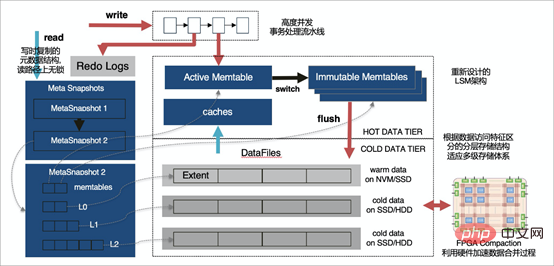
Split the data into different threads at the storage layer, and multiple threads will perform parallel calculations. The results of the pipeline are summarized into the main thread, and finally the main thread does a simple merge and returns it to the user to improve query efficiency.
Parallel Query utilizes the parallel processing capabilities of multi-core CPUs. Taking the 8-core 32 GB configuration as an example, the schematic diagram is as follows. 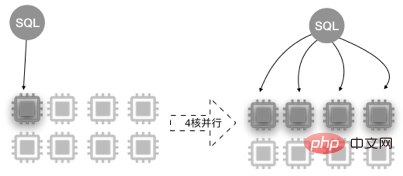
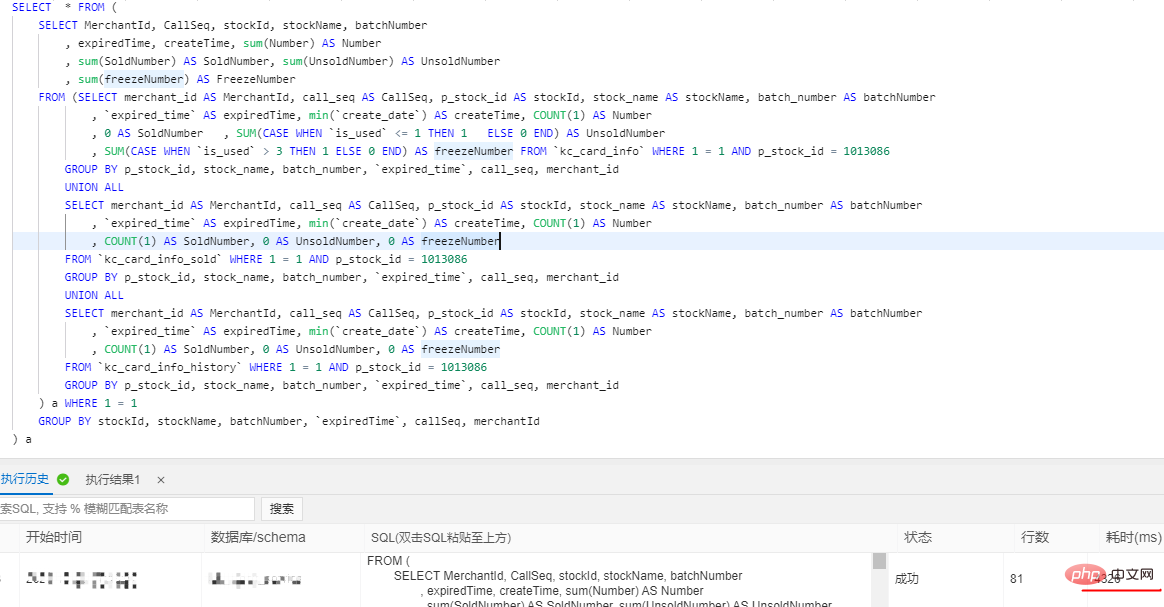
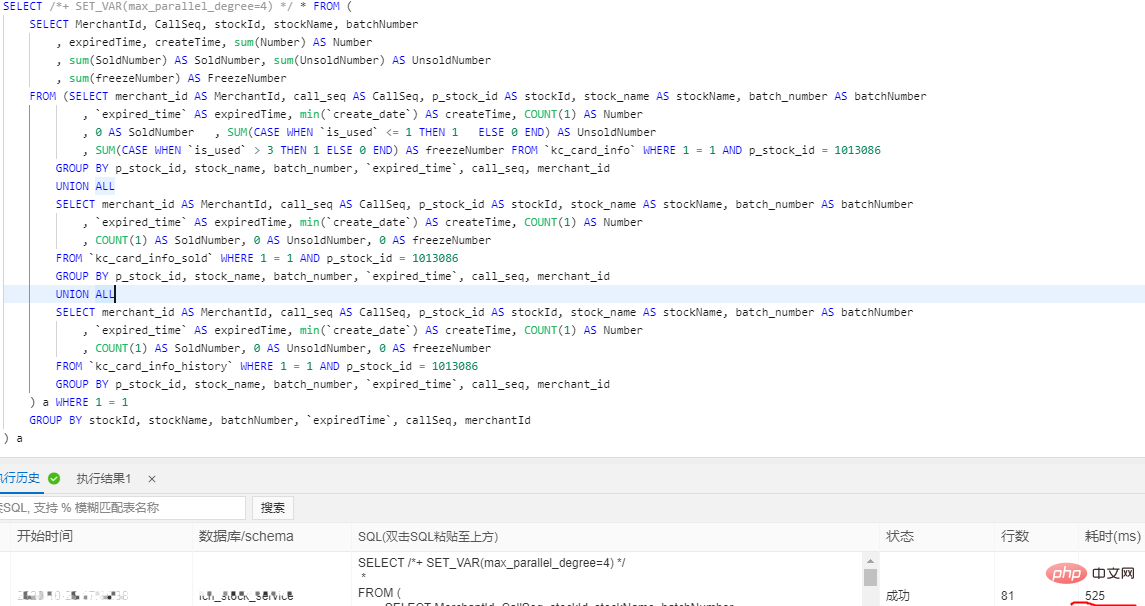
https://help.aliyun.com/product/113622.html) 
The above is the detailed content of Introducing the MySQL large table optimization solution. For more information, please follow other related articles on the PHP Chinese website!

Hot AI Tools

Undresser.AI Undress
AI-powered app for creating realistic nude photos

AI Clothes Remover
Online AI tool for removing clothes from photos.

Undress AI Tool
Undress images for free

Clothoff.io
AI clothes remover

Video Face Swap
Swap faces in any video effortlessly with our completely free AI face swap tool!

Hot Article

Hot Tools

Notepad++7.3.1
Easy-to-use and free code editor

SublimeText3 Chinese version
Chinese version, very easy to use

Zend Studio 13.0.1
Powerful PHP integrated development environment

Dreamweaver CS6
Visual web development tools

SublimeText3 Mac version
God-level code editing software (SublimeText3)

Hot Topics
 MySQL's Role: Databases in Web Applications
Apr 17, 2025 am 12:23 AM
MySQL's Role: Databases in Web Applications
Apr 17, 2025 am 12:23 AM
The main role of MySQL in web applications is to store and manage data. 1.MySQL efficiently processes user information, product catalogs, transaction records and other data. 2. Through SQL query, developers can extract information from the database to generate dynamic content. 3.MySQL works based on the client-server model to ensure acceptable query speed.
 Laravel Introduction Example
Apr 18, 2025 pm 12:45 PM
Laravel Introduction Example
Apr 18, 2025 pm 12:45 PM
Laravel is a PHP framework for easy building of web applications. It provides a range of powerful features including: Installation: Install the Laravel CLI globally with Composer and create applications in the project directory. Routing: Define the relationship between the URL and the handler in routes/web.php. View: Create a view in resources/views to render the application's interface. Database Integration: Provides out-of-the-box integration with databases such as MySQL and uses migration to create and modify tables. Model and Controller: The model represents the database entity and the controller processes HTTP requests.
 How to start mysql by docker
Apr 15, 2025 pm 12:09 PM
How to start mysql by docker
Apr 15, 2025 pm 12:09 PM
The process of starting MySQL in Docker consists of the following steps: Pull the MySQL image to create and start the container, set the root user password, and map the port verification connection Create the database and the user grants all permissions to the database
 Solve database connection problem: a practical case of using minii/db library
Apr 18, 2025 am 07:09 AM
Solve database connection problem: a practical case of using minii/db library
Apr 18, 2025 am 07:09 AM
I encountered a tricky problem when developing a small application: the need to quickly integrate a lightweight database operation library. After trying multiple libraries, I found that they either have too much functionality or are not very compatible. Eventually, I found minii/db, a simplified version based on Yii2 that solved my problem perfectly.
 How to install mysql in centos7
Apr 14, 2025 pm 08:30 PM
How to install mysql in centos7
Apr 14, 2025 pm 08:30 PM
The key to installing MySQL elegantly is to add the official MySQL repository. The specific steps are as follows: Download the MySQL official GPG key to prevent phishing attacks. Add MySQL repository file: rpm -Uvh https://dev.mysql.com/get/mysql80-community-release-el7-3.noarch.rpm Update yum repository cache: yum update installation MySQL: yum install mysql-server startup MySQL service: systemctl start mysqld set up booting
 Centos install mysql
Apr 14, 2025 pm 08:09 PM
Centos install mysql
Apr 14, 2025 pm 08:09 PM
Installing MySQL on CentOS involves the following steps: Adding the appropriate MySQL yum source. Execute the yum install mysql-server command to install the MySQL server. Use the mysql_secure_installation command to make security settings, such as setting the root user password. Customize the MySQL configuration file as needed. Tune MySQL parameters and optimize databases for performance.
 Laravel framework installation method
Apr 18, 2025 pm 12:54 PM
Laravel framework installation method
Apr 18, 2025 pm 12:54 PM
Article summary: This article provides detailed step-by-step instructions to guide readers on how to easily install the Laravel framework. Laravel is a powerful PHP framework that speeds up the development process of web applications. This tutorial covers the installation process from system requirements to configuring databases and setting up routing. By following these steps, readers can quickly and efficiently lay a solid foundation for their Laravel project.
 MySQL and phpMyAdmin: Core Features and Functions
Apr 22, 2025 am 12:12 AM
MySQL and phpMyAdmin: Core Features and Functions
Apr 22, 2025 am 12:12 AM
MySQL and phpMyAdmin are powerful database management tools. 1) MySQL is used to create databases and tables, and to execute DML and SQL queries. 2) phpMyAdmin provides an intuitive interface for database management, table structure management, data operations and user permission management.






